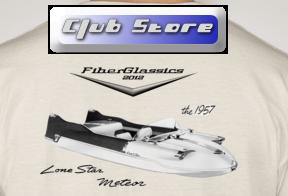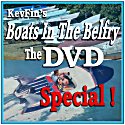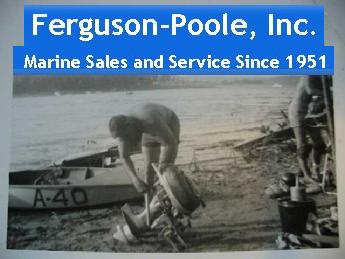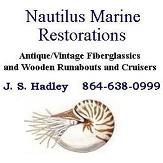FiberGlassics ® is a registered trademark. It’s use is subject to the legal protections afforded by this status. Use of the term Fiberglassics without express written permission is prohibited.
This doesn’t mean that you can’t post a photo of your boat collection and say – “Look at all my FiberGlassics !” It does mean that if you start a club, open a shop, hold an event, create your own website, etc. , you can’t use the term FiberGlassics without written permission. If you're not sure, please ask.
Our Trademark 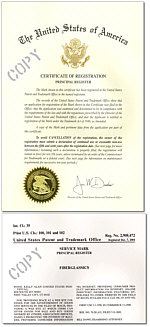 below:
below:
Understanding your Propeller
Identifying your propeller
The size of a prop is described using two sets of numbers. (e.g. 14 X 19) The first number designates the diameter, and the second number designates the propeller pitch.
Propeller Terminology:
Diameter
Diameter is the width of the circle described by the rotating blades.


Pitch
Pitch is the theoretical distance a prop moves forward in one revolution. The following propeller has a pitch that will theoretically result in 24” of forward travel in one revolution. However, in the real world, the propeller experiences “slippage” so that its actual travel per revolution is less than the stated pitch.


Prop pitch is frequently misunderstood. Many people mistakenly believe that switching to a larger pitch prop will make the boat go faster. If a prop with too large a pitch is used, the motor simply doesn't have enough horsepower to turn the prop adequately and the RPM level drops. Not only does the boat go slower, but the motor can load up and the plugs become fouled. If a prop with too low a pitch is used the prop can exceed the manufacturers recommended RPM level and damage the engine.
The ideal situation is to select a prop with a pitch that allows the motor to reach the maximum RPM suggested by the engine manufacturer without going over. If the prop selected doesn't reach the recommended RPM level, the boat will sacrifice speed and lift.
Here's a simple rule of thumb to follow when experimenting with prop pitch. Remember that at wide-open RPM increasing the prop pitch reduces RPM levels by roughly 200 rpm's per inch of pitch. In other words, when switching from a 23- to a 25-pitch prop, the maximum RPM level will drop approximately 400 rpm's. The reverse is true when going down in pitch size.
Propeller Cup
Many of today's propellers incorporate a cup at the trailing edge of the propeller blade. This curved lip on the propeller allows it to get a better bite on the water. This results in reduced ventilation, slipping, and allows for a better hole shot in many cases. A cupped propeller also works very well where the motor can be trimmed so that the propeller is near the surface of the water. The cup will typically result in higher top end speed on one of these applications. Switching from an un-cupped to a cupped propeller will reduce your RPM. The actual amount of RPM decrease is dependent on where, how much, and the quality of the cupping. Typically, a cupped propeller of the same pitch and diameter will reduce your RPM by approximately 200.


Ventilation
Air from the water surface or exhaust gases from the exhaust outlet being drawn into the prop blades causes ventilation. When this situation occurs, boat speed is lost and engine RPM climbs rapidly. This occurs most often with high transom mounting, over-trimming the engine, or sharp turns.
Cavitation
Cavitation (often confused with ventilation), is a phenomena of water vaporizing or "boiling" due to the extreme reduction of pressure on the back of the propeller blade. Many propellers partially cavitate during normal operation, but excessive cavitation can result in metal erosion or "cavitation burn" to the prop's blade surface. There are numerous causes of cavitation such as incorrect matching of prop style to application, incorrect pitch, damage to the blade edges, etc.
Rake
Rake is the measurement of the angle of the tilt of the blade's tip toward or away from the gearcase. The angle is measured on a line extending from the center of the hub through the center of one blade.


Selecting the right propeller
The best propeller size for your boat and engine combination is based on the recommended operating range at wide open throttle (w.o.t.) for your engine, which you will find in your engine operator's manual.
The goal in prop selection is to determine what propeller style and size will maximize performance for your boat, while allowing your engine to operate in the recommended RPM range. The correct propeller will prevent the engine from over-revving, yet allow it to reach the minimum RPM where maximum horsepower is produced.
Run the boat/motor at w.o.t. under normal operating load to determine the maximum RPM you are able to obtain. Adjust the motor trim angle for the optimum performance. If during this test, you begin to exceed the maximum rated RPM of the engine, reduce throttle setting to a position where maximum RPM is not exceeded.
If your test results in your being able to over-rev the engine, you need to increase the pitch of the propeller. Increasing the pitch increment by 1" will result in approximately a 200 RPM drop. If your testing shows, however, that you are only able to obtain a RPM somewhat lower than the maximum rating given by your engine manufacturer, you would need to decrease pitch. Decreasing pitch would increase your RPM. Once your wide open throttle RPM falls within the recommended range of the engine manufacturer, you have a propeller that is suited correctly for your boat with respect to RPM.
If you use your boat for fishing, cruising and skiing, one prop probably won't do all three things equally well. It is best in circumstances like this to have two propellers; One to accommodate one set of circumstances and the other to perform best under the different load. It is imperative, however, that the wide open throttle RPM fall within the range specified by your engine manufacturer.
Aluminum or Stainless?
Aluminum props are the ideal choice for small- to medium-sized boats and motors. Available up to 23 pitch, aluminum props are also the logical choice for use in areas where prop damage comes with the territory. The average aluminum prop costs about $150 compared to $400-$500 for stainless propellers.
Stainless steel props are more expensive, but they offer several advantages. They deliver more performance and are available in larger pitch sizes. One reason stainless props provide more performance than similar pitch aluminum models is because the steel blades are rigid and they don't flex under power. The blades on an aluminum prop actually bend when the prop is in use, reducing the overall size of the prop by approximately one pitch size. Stainless props also provide increased bow lift, especially on heavy boats. The more bow lift a prop provides, the faster and smoother the boat will ride at high speed and in rough water.
Three-Blade, Four-Blade, or Five-Blade?
Propellers are available in three-blade, four-blade and five-blade models. Multiple blade props came on the scene in response to high horsepower outboards that are typically mounted higher on the transom than smaller motors. Because the prop runs closer to the surface, the extra blades help to provide bite and stability at high speed
The advantages of props with extra blades are they provide quicker take-offs, and allow the boat to be kept on plane with fewer engine rpm's. However, they are slower at top-end speeds. A quality three-blade prop is normally two or three miles per hour faster at top end than the same pitch prop featuring multiple blades.
Maintenance
Check your propeller often for nicks, rolled tips, or bent blades. Any distortion from normal will cause a loss in performance and can create vibrations harmful to the engine. A propeller with worn blades will allow the engine to accelerate beyond the recommended operating range which can result in damage to the engine.
Keep the bottom of the boat clean. A fouled bottom, an accumulation of marine growth, moss and barnacles in sea water, and the accumulation of dirt, slime, lime, and other matter in fresh water, is the major cause of poor boat performance. Cleaning the boat's bottom frequently during your boating season will greatly improve boat performance.
Things to Remember
1. Engine RPM at W.O.T. must be within the recommended operating range with the rated horsepower RPM as the target number (see specification in your engine operator's manual).
2. Increasing or decreasing prop pitch directly affects engine load throughout its RPM range.
3. Trim angle affects propeller performance.
4. Atmospheric pressure, elevation, temperature, and humidity all affect engine performance, which directly affects propeller performance.
5. Salt water is more buoyant than fresh water; this may cause some hulls to run faster than identical freshwater setups.
6. Water conditions can play a big part in boat performance and propeller efficiency.
7. The boat's load and position of the load can significantly affect performance.
Other tidbits
Hector Gutierrez wrote on Wed Aug 1, 2001 3:39:19 PST in response to a posting on props:
Here is a handy little formula to calculate your theoretical speed for a given RPM. Us Mechanical Engineers have nothing better to do than to come up with this stuff. How close is your actual speed to the calculated? For my boat it was off by 1 MPH!
(Prop Pitch x RPM)
------------------- = Theoretical Speed in MPH
(Gear Ratio x 1056)
Example:
Prop size = 15" x 17"
Gear Ratio 1.68
WOT = 4,000 RPM
(17 x 4,000)
------------- = 38.33 MPH
(1.68 x 1056)
My actual was about 37 MPH
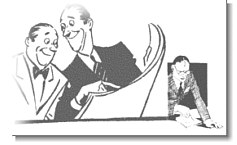
 The FiberGlassics® web site has a unique and dedicated following in the boating community. Statistically speaking the site ranks high in traffic on the web and has a very active community of boating enthusiasts. To help support the site, FiberGlassics® offers commercial members a number of ways to reach our members.
The FiberGlassics® web site has a unique and dedicated following in the boating community. Statistically speaking the site ranks high in traffic on the web and has a very active community of boating enthusiasts. To help support the site, FiberGlassics® offers commercial members a number of ways to reach our members.
The following is a list of ways (and costs) for commercial entities to advertise on FiberGlassics®.
1. Rotating Banner Ads: Banner ads appear on every page of the site except for the Library. The ads rotate on some pages and on others they are randomly displayed. Advertisers get a graphic banner ad that will link the member to your site. The following is an example of a banner ad:
The dimensions of these ads are 180 wide by 170 tall pixels.

The cost for a banner ad is $200 per year. Click statistics are available. Graphic design and layout is available for an extra charge to create an attractive ad.
2. Glassic Businesses Section: This area features your business card with logo, text and links to your site for only $40/year. This is the basic place to start advertising your business on FiberGlassics®. You can ad a "media" file such as a video or sound file to your business listing for an additional $20 per year per file. Your ad will be featured on several pages including the forums on the right hand side under "Glassic Businesses".
An example of a business listing with an audio media file is found here: www.fiberglassics.com/index.php?option=c...i2Id=1&Itemid=74
3. Weblinks: To include your commercial site in the Weblinks section which directs members to your site, the cost is $20 per year.
4. Glassified Ads for Commercial Businesses: You may display one commercial ad in the Glassifieds for $30 per month. If your company has more than one product you would like to feature, please contact us for a discussion of your needs.
5. Forum Advertising: Commercial posts in the Forums is not allowed. If you wish to have your company listed as a Forum Sponsor (at the top of the forum), we accept one Sponsor per month. The cost is $50 per month.
6. Mailing List: There is a dedicated mailing list that users can subscribe to that is opt-in and is titled, "Messages from our sponsors". Your advertisement can be included in this for $50.00 per emailing.
FiberGlassics® reserves the right to review and approve or deny any advertising on the website. All prices and policies are subject to change without notice.
If you would like to advertise on this site, please use the Contact Form
Thank you for your interest!
{chronocontact}contact{/chronocontact}
Hello all,
Our gathering of old friends and new friends and classic boats in Beloit was great fun. We had a good turnout of FGC members and many others as well. Good weather and the hospitality of the Star Zenith Boat Club added to a most enjoyable weekend on the Rock River in beautiful Wisconsin.
.jpg)
Read more: Midwest All-Classics 2014
Fiberglassics® is the Internet powerhouse of classic fiberglass boating sites.
With more members and visits than all other “glassic” boating sites combined, we offer great visibility and opportunity to advertisers who are interested in putting their products and services in front of the most active classic fiberglass boating community on the planet.
We have advertising options to suit all sizes, from large corporations to small businesses. To find out more about advertising on Fiberglassics® see the details at "how to advertise" or send us an email to This email address is being protected from spambots. You need JavaScript enabled to view it.

